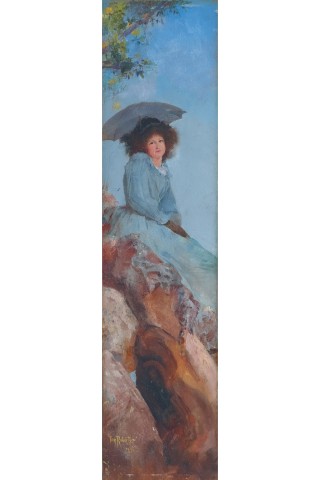A MODERN ANDROMEDA, 1892
TOM ROBERTS
oil on wood panel
45.0 x 10.8 cm
signed and dated lower left: Tom Roberts . / 1892
Henry W Callan, Sydney, framers label attached verso
Henri Kowalski (1841 – 1916), Sydney and Plouër-sur-Rance, France
Thence by descent
Louise Kowalski (née Éloy, AKA Louise Ferraris, 1844 – 1922, m.1869), Château du Chêne-Vert, Plouër-sur-Rance, France
Thence by descent
Madame Lemonnier, niece of the above, Château du Chêne-Vert, Plouër-sur-Rance, France
Mr Roland Brouard, France, 1924, along with purchase of the Château du Chêne-Vert, Plouër-sur-Rance, France
Thence by descent
Louise Brouard (née Louët), France, wife of the above, in 1934
Thence by descent
Marie-Thérèse Rouxel (née Brouard), Nantes, daughter of the above, in 1969
Jack-Philippe Ruellan S.A.R.L., Vannes, France, 27 February 2021, lot 99 (as ‘Jeune Fille à l’ombrelle, assise sur un rocher’)
Private collection, Sydney
Spring Exhibition, Art Society of New South Wales, Sydney, 1892, cat. 50
Eagle, M., The Oil Paintings of Tom Roberts in the National Gallery of Australia, National Gallery of Australia, Canberra, 1997, p. 61 n. 6
NOVL21 Cat proof 7_10_2021 B (2) (002).jpg
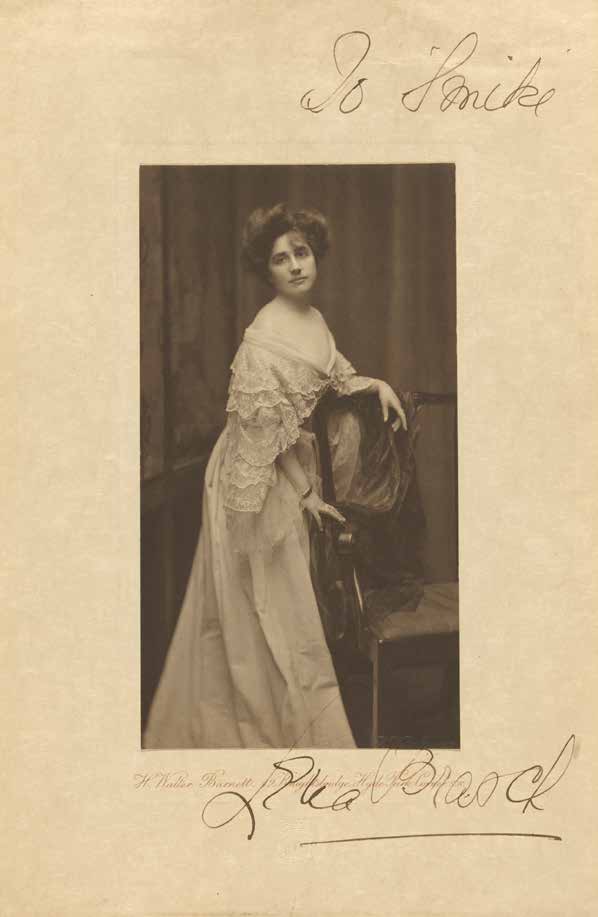
VIEW FLIPBOOK CATALOGUE
Recently rediscovered and repatriated from a private collection in France, Tom Roberts’ A Modern Andromeda, 1892 is, although modest in scale, a painting of considerable art historical significance. Not only is it a fine example of the artist’s simultaneously crisp and fluent Naturalist style, completed at a high point in his career1, but it also carries a rich freight of associations and information – revealing much about the life (and loves?) of the artist; painting in Melbourne and Sydney at the time; and the close links between various branches of the arts in the late 19th century.
In ‘Marvellous Melbourne’, financial capital of the Australian colonies, a collapse in property prices in 1889 and associated building society failures the following year created wider economic anxieties. The market for contemporary art had never been particularly secure, and Victoria’s painters had long contested the National Gallery of Victoria’s acquisition policies, which did not favour local artists. These factors, together with a desire to explore landscapes and pastoral industry ‘national subjects’ further afield, took Tom Roberts away from the city. In 1890 – 91, he was only sporadically to be found at his Melbourne studio, having gone ‘on the wallaby’ to Tasmania, East Gippsland and the Central Highlands, as well as back to Corowa on the Murray, where he had begun painting Shearing the Rams in 1889. Eventually – possibly in immediate pursuit of the prospect of a £75 acquisition from a competition for ‘water-colour drawings illustrating what is most picturesque in the scenery of New South Wales, especially in the remoter districts of the colony,’2 – Roberts and his friend and Heidelberg School colleague, Arthur Streeton (together with Streeton’s mother), took ship for Sydney in the Massilia in early September.
Roberts went straight to Curlew Camp, a cheap-rent single men’s tent village on the North Shore at Little Sirius Cove, Mosman Bay. Apart from a brief visit to the Hunter River in pursuit of a watercolour subject (one of his entries in the National Gallery’s watercolour exhibition in 1891 was Coaling at Newcastle), he would remain there throughout the spring and summer, until he returned to Melbourne for a month in February 1892.3
The camp was an initiative of Reuben Brasch, Sydney clothing manufacturer and retailer and an acquaintance of the artist.4 Just as Roberts’ good friend and fellow Box Hill plein-airiste, Louis Abrahams, had provided the cedar cigar box lids used for many of Roberts’, Streeton’s and Conder’s ‘9 by 5 Impressions’, it appears that so did Reuben Brasch supply the long, narrow ‘drapers’ panel’ supports that became a feature of the Australian Naturalists’ (and particularly Streeton’s) images of Sydney Harbour. A Modern Andromeda would appear to be the first work to employ this striking format, pre-dating both Streeton’s horizontal Harbours of 1893 and his vertical Sirius Cove ‘keyholes’ of 1895.
Reuben Brasch’s sister Golda had married Louis Abrahams in March 1888, and Roberts was a witness at the wedding, held in the Brasch family home in Sydney. It was probably on that occasion that Roberts first met Reuben and Golda’s little sister, the teenage Selena Venus. When he returned to Sydney and settled at Curlew camp, Roberts renewed his connection with the young woman, almost immediately enlisting her to pose in the coastal landscape. The rocks on which the figure in the present work is sitting look very much like the tumble of sandstone boulders on the eastern side of Sirius Cove, while the wattle blossom at the top of the composition clearly implies a springtime sitting.
NOVL21 Cat proof 7_10_2021 B (2) (002).jpg
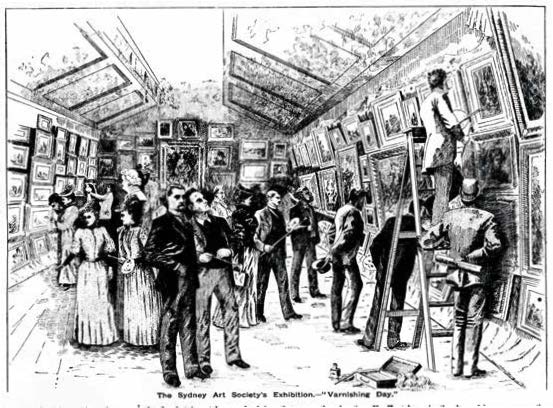
This latter assumption is reinforced by correspondence from Streeton, who visited the camp probably late September, before heading up to Glenbrook to paint Fire’s On, 1891 (Art Gallery of New South Wales, Sydney). In letters written from Melbourne the following January, Streeton inquires 'How also dear Mossmans + your pretty sitter with abundant hair fanned by the afternoon breeze at the point,’5 and also specifically references a small painting of ‘Miss_____ on the rocks,’ advising Roberts not to let the work sell cheaply: ‘it is so charming – keep it as a memento of the place.’6 Is Streeton’s discretion with regard to the sitter’s identity a bit of a tease, a suggestion that Roberts may have harboured some amorous intent in relation to the young Miss Brasch? There is something admiring, even worshipful in the low da sotto in sù viewpoint, with the blue dress seen against the blue Sydney sky making the figure of the girl somehow ethereal, heavenly. The limpid cerulean of the subtropical sky seems to have been just what Roberts craved after a grey winter down south; we see that colour again in the extravagant bows of another of his entries in the 1892 Art Society exhibition, The Paris Hat, 1892 (New England Regional Art Museum, Armidale). In the present picture there is even a tiny shard of summer, a triangle of blue sky, visible through the rocks.
In any event, Roberts was certainly very taken with Lena as a model; she appears in no fewer than half a dozen pictures over the ensuing decade.7 The interest is perfectly understandable. Lena Brasch was an attractive, vivacious, talented young woman, who would later make something of a name for herself on the London stage. Not surprisingly, given her family’s piano-importing business background, she was also ‘a pianiste of no mean ability,’8 and Roberts is known to have been particularly fond of music.9
This musical connection also explains the present work’s ‘disappearance’ for more than a century. Before its recent return to Australia, the painting passed by descent and estate purchase from the family of pianist, composer and teacher Henri Kowalski. Of Polish heritage but Breton-born and Paris-trained, Kowalski performed in Brussels, London, the United States and Canada before coming to Australia both as a judge for the Fine Arts section of the 1880 Melbourne International Exhibition, and to give concert performances. During this visit he enthusiastically embraced the local culture; he collaborated with Victorian novelist and poet Marcus Clarke on a comic opera, Queen Venus, and even composed a waltz entitled The Belles of Melbourne. Returning to Australia in 1885, Kowalski lived and worked in Sydney for twelve years, during which time he ‘conducted choirs, orchestras and operas, set up music societies, and had an extensive private teaching practice and a major public profile as a performer. He also set up a public examination board and worked as a music critic.’10
HWalterBARNETT-HenriKowal-De103150.jpg
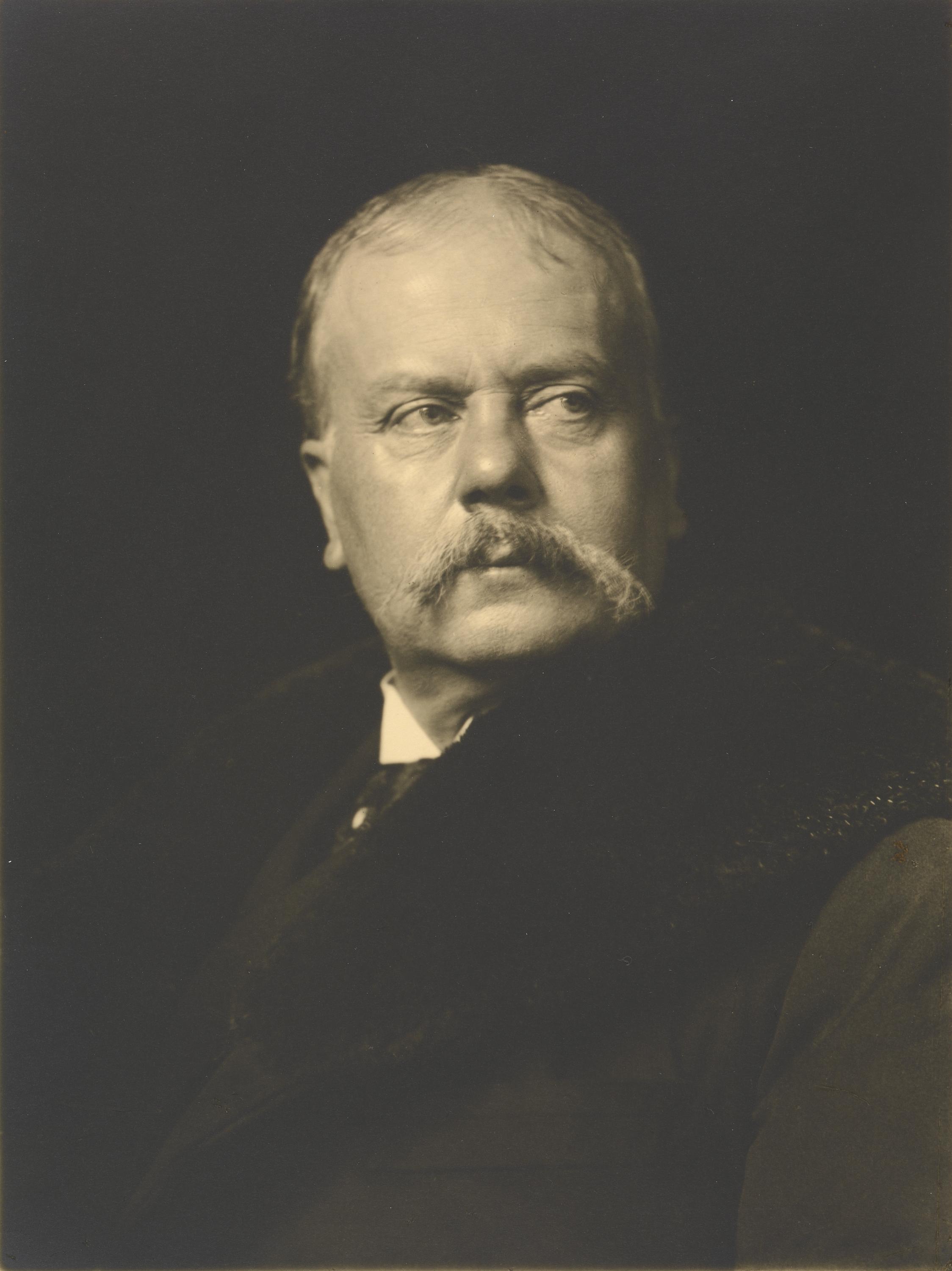
Kowalski was definitely known to Tom Roberts; a portrait was included in the artist’s extensive and wide-ranging 1900 exhibition and sale.11 Given Sydney’s relatively small musical community, he is also likely to have been familiar with the piano-retailing Brasch family, including young Lena: she may have been one of the 45 pupils who signed an illuminated address presented to him by the Mayor of Sydney in October 1892, while a couple of years later an advertisement for her first published composition, The Olga Waltz, includes a personal testimonial from the maestro.12 What is beyond doubt is that Kowalski was familiar with the present painting; he and his violinist compatriot Horace Poussard performed a duet at a conversazione held in association with the 1892 Art Society exhibition at which the work was first shown.13
But what is the meaning of the curious title? In ancient Greek mythology, Andromeda was the daughter of Cepheus, king of Aethiopia. Andromeda’s mother, Cassiopeia, boasted that her daughter was more beautiful than the Nereids, sea-sprite companions of the ocean god Poseidon, and in revenge for this hubristic affront, Poseidon sent a tidal wave and the sea-monster Cetus to ravage the Aethiopian coast. Having been told by an oracle that in order to placate the god he must sacrifice his daughter, King Cepheus had Andromeda chained to a rock at the edge of the sea to await her doom. Happily, the hero Perseus, flying home after having slain the Gorgon, saw the girl, killed the monster and (naturally) claimed Andromeda in marriage.
Perhaps unsurprisingly, the image of the naked, constrained and vulnerable Andromeda appealed to patriarchal sensibilities, with Andromeda in chains becoming a familiar trope through the writings of the Greek playwrights Sophocles and Euripides and the Roman poet Ovid, and accordingly, a persistent focus of the male gaze in European art: from Pompeiian wall painting to the Renaissance Piero di Cosimo, from Titian and Vasari to Rubens and Rembrandt.14 The popularity of the subject persisted through the 19th century and into Roberts’ time, as can be seen in works by (inter alia) Eugène Delacroix, Gustave Doré and Gustave Moreau.15 In the British tradition with which Roberts was most familiar, the Pre-Raphaelite Edward Burne-Jones developed (though never completed) a full cycle of Perseus pictures for the Music Room of young Conservative politician Arthur Balfour’s house in Carlton Gardens, London; a preparatory painting for this series depicting the Andromeda episode is now held by the Art Gallery of South Australia.16
Frederic Leighton Perseus_and_Andromeda.jpg
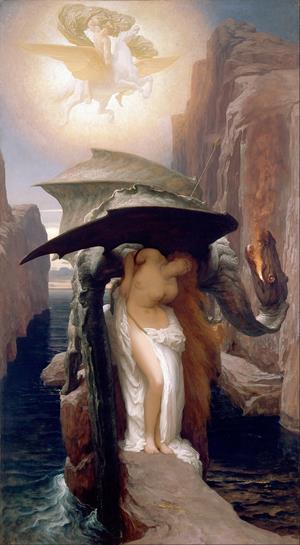
In relation to the present picture, however, there is a more concrete and plausible link to a specific work by Sir Frederic (later Lord) Leighton. A member of the Royal Academy since 1868, its President since 1878, created a baronet in 1886, an officer of the Légion d’honneur and a member of the Institut de France, in 1891 Leighton’s reputation was at its height, even as far from London as the Australian colonies. That year Queenslander William Knox D'Arcy, the Mount Morgan Gold King, purchased his The Garden of the Hesperides, and the Sydney gallery a photograph of The Bath of Psyche, while in an article on the New South Wales collection written for the Melbourne Argus, Roberts specifically mentioned both Leighton’s classical-domestic fantasy Wedded (purchased 1882), and watercolours for the Arts of industry… frescoes at the South Kensington Museum (now the Victoria and Albert).17 In 1891, Leighton painted his version of the Andromeda myth, with the sea-monster depicted more as a dragon than as a whale or crocodile. Perseus and Andromeda was shown in the RA’s summer exhibition, and was reproduced in the London Art Journal for June.
Dr Hansen is most grateful to Dr Leigh Astbury and to Dr Keren Hammerschlag, Lecturer in Art History and Art Theory, Australian National University, for their assistance in preparing this catalogue essay
DR DAVID HANSEN
ASSOCIATE PROFESSOR, CENTRE FOR ART HISTORY & ART THEORY,
AUSTRALIAN NATIONAL UNIVERSITY
1. 1891-2 was something of an annus mirabilis for Tom Roberts. He completed the large, ambitious A Break Away! 1891 (Art Gallery of South Australia, Adelaide), while the Art Society of New South Wales show in which the present work was first shown included the formal triptych of ‘Church, State and the Law’ portraits (Cardinal Moran, Sir Henry Parkes and Sir William Windeyer); the sensitive Eileen, 1892 and the powerful Aboriginal Head - Charlie Turner, 1892 (both Art Gallery of New South Wales, Sydney). 1892 was also the year he travelled north to Queensland and the Torres Strait, a journey that generated some memorable images, particularly of First Nations Australians.
2. The Sydney Morning Herald, 18 February 1891, p. 7
3. Curlew Camp would remain the artist’s main residence until his marriage to Lillie Williamson in April 1896.
4. Marcus Brasch and his brother Wolfe were Prussian Jews who had migrated to London in 1848, then to Melbourne in 1866; Wolfe and his extensive family later moved to Sydney. The family music store (employing the persuasive slogan ‘A home is not a home without a piano’) eventually expanded to become (with the Germanic ‘c’ dropped during the Great War) the national music and electronics chain Brashs.
5. Letter, Arthur Streeton to Tom Roberts, 17 January 1892, Roberts Papers, ML A2428, State Library of New South Wales, Sydney
6. Letter, Arthur Streeton to Tom Roberts, 16 January 1892, Roberts Papers, ML A2478, State Library of New South Wales, Sydney. Mary Eagle, formerly Senior Curator of Australian Art at the National Gallery of Australia, first proposed that the work to which Streeton is referring in this letter is A Modern Andromeda (then untraced). See Mary Eagle, The oil paintings of Tom Roberts in the National Gallery of Australia, National Gallery of Australia, Canberra, 1997, p. 61 n. 6
7. (profile portrait sketch of Lena Brasch) c. 1892, private collection; sold Christie’s Australia November 1992); (unfinished portrait study) 1893, National Gallery of Australia, Canberra; An eastern princess 1893, National Gallery of Australia, Canberra; Plink a plong 1893, Art Gallery of South Australia, Adelaide; and possibly the later A study of Jephthah’s daughter 1899, Art Gallery of New South Wales, Sydney. The profile sketch also has a press cutting pasted on the reverse (‘Australians in England’, Sydney Morning Herald, 28 January 1905, p. 5) which mentions another, still later portrait of Lena, from 1904. By this time Lena was evidently sufficiently intimate with the Heidelberg School artists to have known and used their nicknames. A 1901 portrait photograph by Walter Barnett that she gave to Streeton (National Gallery of Australia, Canberra) is inscribed ’To Smike.’
8. ‘The theatre: musical and dramatic notes’, The Star (Christchurch), 26 September 1904, p.4
9. The painter’s devotion to the Euterpean muse is amply attested not only in letters, records of attendance at concerts, and the various musical activities of the clubs and societies with which he was associated, but also in his personal relationships: with Prof. G.W.L. Marshall-Hall, Melbourne’s musical colossus of the 1890s and early 1900s, with life-long friend S.W. Pring, an amateur flautist, and with Duncan Anderson of ‘Newstead’ station, a keen cornetist. Roberts’ oeuvre includes numerous musical subjects: portraits of musicians Nellie Billings (1900), Alice Bryant (1899), Daddy Hallawell (late 1890s), Alfred Hill (1897), Johann Kruse (1895), Marshall-Hall, of course, and Nellie Melba (c.1902), as well as subject pictures such as The violin lesson, c. 1889 (National Gallery of Victoria); Andante, 1889 (Art Gallery of South Australia, Adelaide); The troubadour of Scott’s, c.1889 (Westpac Corporate Art Collection, Sydney); and Adagio, c.1893 (Art Gallery of New South Wales, Sydney). See Kertesz, E., ‘Music and the Australian Impressionists’, in Gray, A. and Hesson, A. (eds), She-Oak and Sunlight: Australian Impressionism, Thames & Hudson, in association with the National Gallery of Victoria, Melbourne p. 229). Kertesz believes the violinist in this last to be ‘probably Lena Brasch’; it is here suggested that the subject is more likely to be Bessie Doyle, one of whose signature performance pieces was the Adagio from Spohr’s 9th concerto in D minor. Miss Doyle performed extensively in Sydney and country New South Wales between June and November 1892, and she and Henri Kowalski headlined a concert in Sydney on 5 November (The Daily Telegraph, 2 November 1892, p. 2).
10. Murphy, K., ‘Henri Kowalski (1841-1916): a French musician in colonial Australia’, Australian Historical Studies, vol. 48 no. 3, August 2017, pp. 358 – 9
11.‘Sale of Mr Roberts’s paintings’, The Sydney Morning Herald, 14 November 1900, p. 5
12. ‘The Olga Waltz by Lena V. Brasch’, The Sydney Morning Herald, 23 June 1894, p. 2. Kowalski’s encomium reads: ‘I like the Strauss character of the Olga Waltz, and the first musical steps of Miss Lena V. Brasch deserve good commendation from both dilettanti and choreograph [sic]’ The waltz, written for piano, was named in honour of the actress Olga Nethersole.
13. ‘Art Society’, The Sydney Mail and New South Wales Advertiser, 10 September 1892, p. 581
14. Unknown artist, Perseus freeing Andromeda, c. 50-75 BCE, Museo Archeologico Nazionale di Napoli, Naples; Piero di Cosimo, Andromeda freed by Perseus, c. 1510-15, Galleria degli Uffizi, Florence; Tiziano Vecelli, Perseus and Andromeda, 1553-59, Wallace Collection, London; Giorgio Vasari, Perseus and Andromeda, 1570-72, Palazzo Vecchio, Florence; Peter Paul Rubens, Perseus and Andromeda, c. 1622, Hermitage Museum, St Petersburg; Rembrandt van Rijn, Andromeda chained to the rocks, c.1630, Mauritshuis, The Hague
15. Eugène Delacroix, Perseus and Andromeda, c. 1853, Staatsgalerie, Stuttgart; Gustave Doré, Andromeda, 1869, private collection; Gustave Moreau, Perseus and Andromeda, 1870, Bristol City Museum and Art Gallery.
16. Edward Burne-Jones, Perseus and Andromeda (‘The rock of doom’ and ‘The doom fulfilled’) 1876, Art Gallery of South Australia, Adelaide.
17. ‘Art’, The Sydney Morning Herald, 31 December 1891, p. 4; Tom Roberts, ‘The National Art Gallery of New South Wales’, The Argus, 31 October 1891, p. 4.
